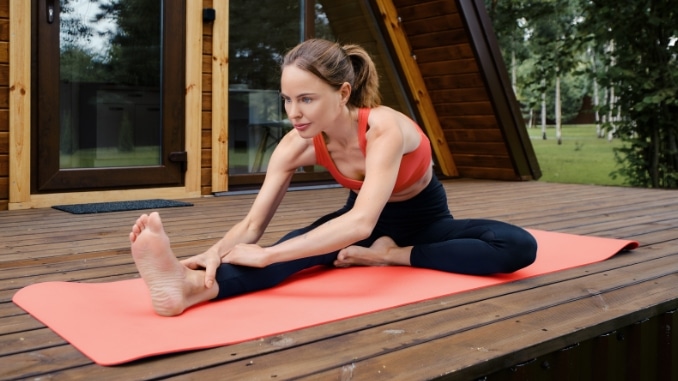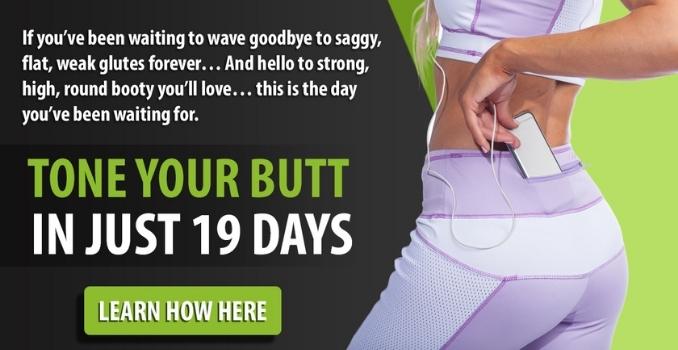Disclaimer: Please note that this content is provided for informational purposes solely and is not intended as medical guidance. Before initiating any new exercise routine, it is recommended to seek advice from a healthcare professional.
Physical strength and functional movement are some of the most important exercise goals. In most Leg day exercises, a glute and hamstring workout is one of the key factors in achieving these things, wielding a profound impact on our overall well-being.
Beyond aesthetics, these muscle groups are often overlooked but are important in maintaining stability, enhancing athletic prowess, and facilitating everyday activities.
Whether you’re an athlete aiming to optimize performance and muscle gain or an individual seeking to enhance strength and functionality, this guide will provide you with the expertise and resources necessary to develop a strong posterior chain.
From foundational movements to advanced techniques, discover how targeted exercises can elevate your leg muscles’ aesthetic appeal and functional prowess, fostering a body that promotes strong legs with grace and resilience.
Best Glute and Hamstring Workout
1. Plantar Flexion
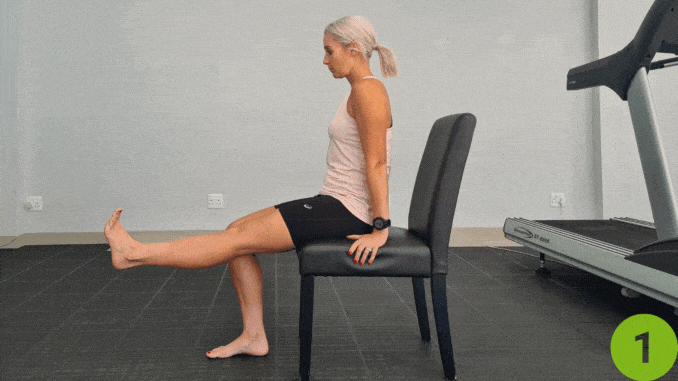
Plantar Flexion
- Begin in an upright sitting position on a chair with your knees bent and feet flat on the floor, maintaining proper alignment with your head, shoulders, and hips.
- Engage your core.
- Lift and straighten one leg out in front of your body.
- Working on the range of motion in the ankle joints, point your toes toward the floor.
- Return to the starting position and repeat the movement.
- Complete the movement for 2 sets of 5 to 10 repetitions on each side.
Tip: To make this glute and hamstring workout easier, utilize another chair to rest your foot on as you perform this movement.
2. Seated Forward Bend
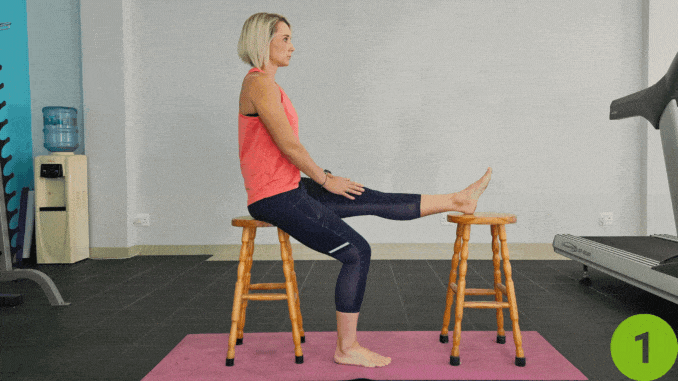
Seated Forward Bend
- Begin in an upright sitting position on a chair with your knees bent and feet flat on the floor, maintaining good alignment with your head, shoulders, and hips.
- Extend one leg in front of your body, resting your heel on the chair with your toes pointed upwards.
- Engage your core and take a deep breath.
- Exhale and hinge through your hips to bend your upper body forward while keeping your leg straight.
- Hold this position for a few seconds.
- Return to the starting position and repeat the movement on the opposite leg.
- Complete for 2 sets of 10 repetitions on each side.
3. Chair-Assisted Downward Dog
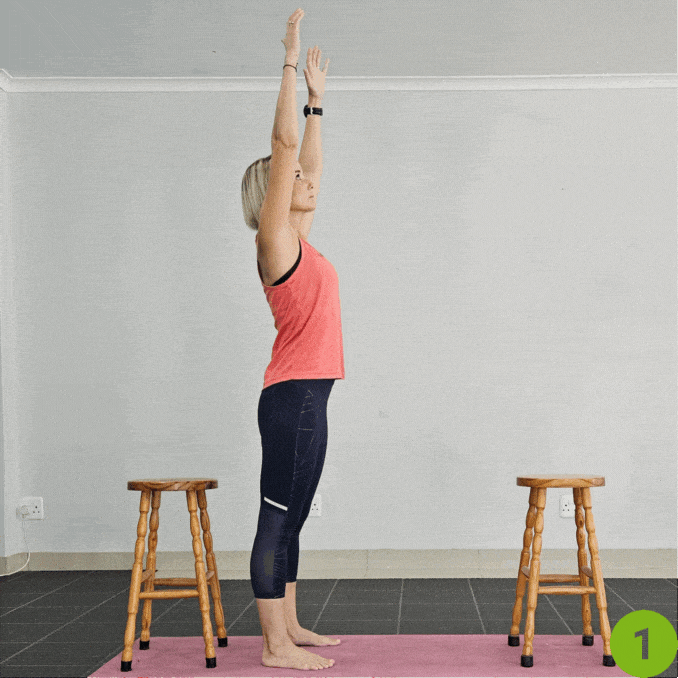
Chair-Assisted Downward Dog
For this glute and hamstring workout, use a chair, bench, or any stable, elevated surface that can hold your body weight.
- Stand upright with the chair in front of your body.
- Contract your core, bend through the hips, and place your hands on the sides of the chair for support.
- Move your feet back to increase the angle of your body.
- Drop your head through your arms, maintaining good alignment with your head, shoulders, and hips.
- Hold this position for 5 to 10 seconds.
- Slowly raise back up to return to the starting position.
- Complete the movement for 3 to 5 repetitions.
Tip: When bending forward, only do so to a point where it will not cause any pain.
4. Cross-Legged Hamstring Stretch
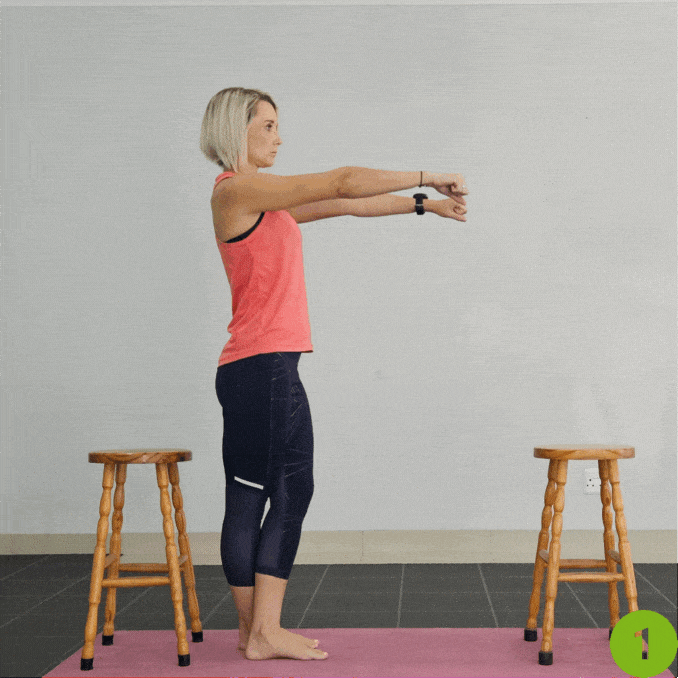
Cross-Legged Hamstring Stretch
- For this glute and hamstring workout, begin in an upright standing position, maintaining good alignment with your head, shoulders, hips, and legs.
- Cross one foot over your opposite ankle and extend both arms in front of your body at shoulder height.
- Tighten your core and hinge through your hips to bend your upper body forward.
- Hold this position for 5 to 10 seconds.
- Return to the starting position and repeat the movement.
- Complete the movement for 3 to 5 repetitions on each side.
The Benefits of Strong Glutes and Hamstrings

1. Enhanced Athletic Performance
Strong glutes and hamstrings are crucial for dynamic movements, agility, and overall athletic performance. In fact, according to a study from the Harvard Medical School, having both the glutes and hamstrings trained to an exterior point makes athletes, whether sprinters, jumpers, or team sport participants, benefit from the power generated by a leg workout that trains lower body muscles.[1]
Additionally, enhanced lower body movement gives athletes a competitive edge in speed and control. Working out the lower body can provide many benefits, such as speed, agility, and control. Engaging in cardio exercise or even participating in leg day training can help.
2. Improved Posture
The glutes and hamstrings are vital in stabilizing the pelvis and supporting the spine. Developing strength in the posterior chain muscles also contributes to better posture, reducing the risk of lower back pain and helping maintain the spinal alignment or prevent it from misalignment.
Good posture acquired from lower body exercises reduces the risk of chronic pain. It helps maintain the spine’s natural curvature, making it a valuable asset in personal and professional life.
3. Injury Prevention
A well-developed posterior chain[2] is a natural safeguard against injuries. Strong glutes and hamstrings help stabilize the knee joint, reducing the risk of common injuries such as ACL tears. Additionally, they contribute to a more balanced distribution of forces during physical activities.
By strengthening these muscles with a compound exercise routine, athletes can maintain the structural integrity of their lower body and minimize the likelihood of injury, ensuring they stay in peak condition for their chosen sport.
4. Balance and Stability
The three muscles in the hips, the gluteus maximus, gluteus medius, and gluteus minimus, play a crucial role in preserving equilibrium and steadiness within the body. Strong glutes help maintain balance, especially during single-leg movements or when navigating uneven surfaces, reducing the risk of falls and injuries.
By improving balance and stability, athletes can move with greater confidence and precision, reducing the risk of falls and injuries that can sideline their performance or training progress. This provides further importance on exercises such as hip thrusts and hip extension.
The glutes and hamstrings are interconnected with the core muscles. Strengthening these areas contributes to overall core stability, essential for functional movements and maintaining a strong, resilient midsection. Understanding the intricate connection between the glutes, hamstrings, and the core is crucial.
5. Enhanced Core Strength
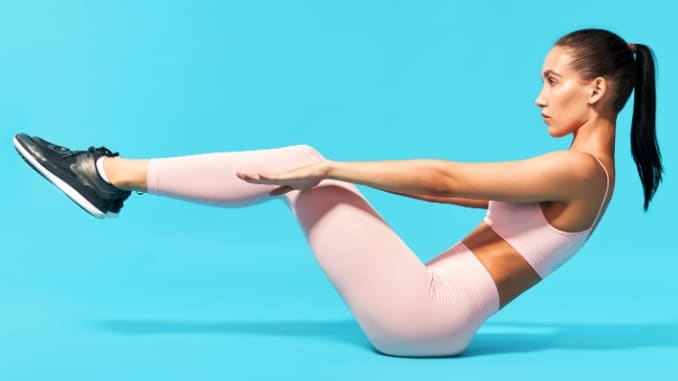
The glutes and hamstrings are interconnected with the core muscles. Strengthening these areas contributes to overall core stability, essential for functional movements and maintaining a strong, resilient midsection. Understanding the intricate connection between the glutes, hamstrings, and the core is crucial.
These muscle groups work together to provide a solid foundation for overall core stability[3] which is essential for various functional movements and maintaining a robust midsection. By strengthening the glutes and hamstrings, you’re fortifying the lower body and reinforcing the central core, including the abdominal and lower back muscles.
Important Points to Remember
Glute and hamstring workout prioritize proper form by maintaining a strong mind-muscle connection and incorporating a thorough warm-up. These are fundamental for an effective and safe workout. The glute and hamstring muscles are sensitive and prone to overwork, so exercise should be done with caution.
People with existing injuries or with age are also susceptible to mistakes, which can lead to either a quick fix or a worsening of the pain.
1. Sensitivity and Overuse Prevention
Be aware that the glute and hamstring muscle groups can be sensitive and prone to overuse injuries. Exercise caution when exercising as people with age or with pre-existing injuries might have smaller muscle mass and much more delicate muscle fibers. These might pose problems, especially when the exercise is intense.
Being mindful of this sensitivity and taking appropriate precautions, such as gradually increasing exercise intensity and seeking professional guidance, is paramount to prevent injuries and guarantee a workout routine that is both safe and efficient.
2. Proper Form and Mind-Muscle Connection
Maintain a strong mind-muscle connection during glute and hamstring workout. Focus on proper form to target the intended muscle groups effectively. Implement a thorough warm-up routine to prepare the body. This connection allows you to fully engage and activate the intended muscle groups, optimizing the effectiveness of your workouts.
To support this, starting your routine with a thorough warm-up is imperative. Avoid going into a hamstring workout immediately. Let your body get used to the exercise first. Doing this allows for greater focus, improved performance, and reduced chances of injury.
3. Pain and Recovery

When you encounter discomfort or pain in your glute and hamstring areas, it is crucial to prioritize recovery for both short-term relief and long-term well-being. Prioritize having adequate rest always and ensure the body has the time to heal and repair.
Skipping rests and pushing forward toward the pain might result in hamstring injuries or worse. The body needs to relax and reset to build muscle effectively before achieving the desired form, whether in the lower or upper body. Without rest, it can only hinder the progress.
During deep sleep, the pituitary gland secretes elevated growth hormone levels, which are crucial for facilitating muscle repair and promoting growth. This hormone stimulates the growth and repair of tissues, including muscle fibers damaged during exercise.
4. Listen to Your Body
Pay attention to signals from your body, including pain, discomfort, or fatigue. Modify or stop exercises if you experience these symptoms. These signals are feedback mechanisms that your body uses to communicate its limits and needs.
It is vital to act promptly when encountering unfamiliar pain or discomfort, whether discomfort from bending your knees or pain in either leg. If it hurts even doing compound exercises, only try out the best glute exercises; otherwise, pushing through pain can lead to injuries.
By heeding these signals, you protect yourself from harm and create an environment conducive to steady and sustainable fitness gains. Watch out for exercises such as hip thrust, knee flexion, and leg curls, as improper execution may lead to injuries.
5. Nutrition and Hydration
Additionally, proper hydration isn’t a simple straight line. It’s a complex blend of proper food diet, and hydration is needed to make you last throughout your routines. Sound nutrition and hydration are the foundation for strength, endurance, and vitality.
6. Consistency and Patience
Maintaining a steady workout routine is crucial for attaining lasting results. Therefore, commit to a consistent exercise schedule. Be patient with your progress and understand that improvements may take time. The cumulative effect of regular exercise leads to significant and sustainable results, whether it’s muscle growth, improved endurance, or enhanced overall fitness.
However, achieving these goals requires patience, as noteworthy transformations often unfold gradually. Understand that your body undergoes numerous changes during your fitness journey, from physiological adaptations to strengthening connective tissues.
These processes take time and dedication. By embracing patience, you allow your body to adapt and progress at its own pace, reducing the risk of burnout or frustration. Remember that each workout contributes to your ultimate success, no matter how incremental it may seem. Consistency and patience are your allies for long-term health, vitality, and fitness excellence.
7. Recovery Tools
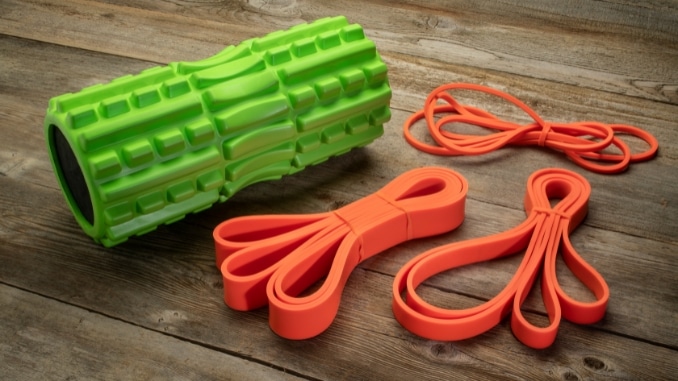
Incorporating recovery tools into your glute and hamstring workout routine can be a game-changer in your quest for peak performance and well-being. Tools like resistance bands, massage devices, and even percussion massagers offer targeted relief for muscle tightness and soreness, effectively promoting recovery.
Foam rolling, for instance, enables you to perform self-myofascial release, aiding in the breakdown of adhesions and knots in your muscles and fascia. Massage devices, including electric massagers and manual massage sticks, provide deeper and more specific muscle relief.
They can enhance circulation, reduce muscle tension, and help with exercises such as hip thrust, executing a leg curl, and even targeting a specific muscle group. Integrating these recovery tools into your post-workout routine can minimize muscle soreness, improve flexibility, and expedite healing.
Conclusion
The journey from understanding the anatomy to implementing practical strategies unfolds a roadmap to sculpting a powerful posterior chain and fostering holistic strength and well-being.
From the foundational principles of proper form, progressive overload, and balanced training to the finer details of mindfulness in progression, breathing technique, and post-workout stretching, this guide has aimed to equip you with the knowledge necessary for an effective and safe workout routine.
As you embark on this transformation journey, remember that the strength of your glutes and hamstrings transcends mere aesthetics, impacting athletic performance, injury prevention, and everyday functionality.
By prioritizing individualized approaches, embracing variety, and respecting the importance of recovery, you lay the groundwork for sustainable progress.
Consider these key points as pillars supporting your fitness endeavors, weaving together the elements essential for a resilient and dynamic posterior chain.
With each intentional repetition and mindful step, you move closer to unlocking the full potential of your glutes and hamstrings — a testament to the fusion of knowledge, dedication, and the transformative power of a well-rounded fitness routine.
If you’ve been waiting to wave goodbye to saggy, flat, weak glutes forever… And hello to strong, high, round booty you’ll love… this is the day you’ve been waiting for. Check out this Glute Lifter Pro now!
Frequently Asked Questions
What type of exercise works on your hamstrings and glutes?
There are tons of exercises that can work in strengthening your hamstring and glutes, but I found that the plantar flexion, seated forward bend, cross-legged hamstring stretch, and the chair-assisted downward dog are the most effective. Especially when you consider the overall safety of performing them, not to mention their ease in doing them.
What is the relationship between the glute and the hamstring?
The glutes and hamstrings work closely together during movements like hip extension and knee flexion, making them key muscles in activities like walking, running, and squatting. While the glutes provide the primary power for hip movements, the hamstrings assist and control the lower leg. A strong relationship between these muscles helps balance the load during motion, preventing over-reliance on one group and reducing the risk of injury.
Should you train glutes and hamstrings together?
Yes, training the glutes and hamstrings together is effective because they often work in tandem during lower body exercises. Combining them in workouts, through movements like squats, deadlifts, and bridges, promotes balance, strength, and coordination in the posterior chain, leading to improved posture, injury prevention, and overall functional fitness.

